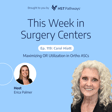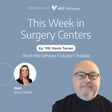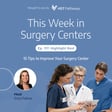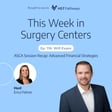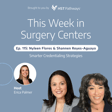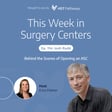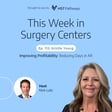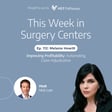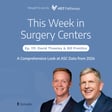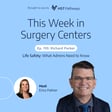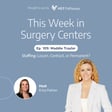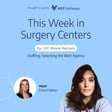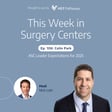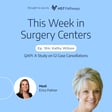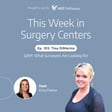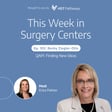Introduction and Agenda
00:00:01
Speaker
Welcome to This Week in Surgery Centers. If you're in the ASC industry, then you're in the right place. Every week, we'll start the episode off by sharing an interesting conversation we had with our featured guests, and then we'll close the episode by recapping the latest news impacting surgery centers. We're excited to share with you what we have, so let's get started and see what the industry's been up to.
00:00:27
Speaker
Hi, everyone. Here's what you can expect on today's episode.
Using Benchmarking to Enhance Care and Performance
00:00:32
Speaker
Gwen Donathan is the clinical director at Roanoke Valley Center for Site, and she's here to share how ASCs can use benchmarking to improve care and your bottom line. With four locations relatively spread out across Virginia, Gwen is off-site most of the time, so she really relies on benchmarking to keep her in the loop on what's going on at each of her locations.
00:00:55
Speaker
In our news recap, we'll cover five new technologies that are shaping the future of surgery, an app calling themselves Uber for nurses, progressive treatments for depression, and a reminder for all healthcare workers after witnessing what happened to Demar Hamlin last week. Hope everyone enjoys the episode and here's what's going on this week in Surgery Centers.
Gwen Donathan's ASC Journey and Expansion
00:01:26
Speaker
Hi, Gwen. Happy New Year. Thanks for joining us today. Can you tell our listeners a little bit about your experience in the AC industry? Absolutely. Thank you for having me. And I'm going to give you just a brief overview of things that I've learned related to the topic. But my experience in the field is I became a registered nurse in 2004 and went to floor nursing, did that for a couple of years.
00:01:51
Speaker
And then just on a chance, I found out that nurses could work in ambulatory surgery centers. And there happened to be one close where I live. I didn't even know it was there, but it was an ophthalmic specialty ASC, two ORs. And I applied and got the job.
00:02:08
Speaker
And I've loved it ever since. I just like that kind of nursing. It's a little bit selfish because patients typically are experiencing positive outcomes as they're walking out the door. We've removed their cataract. They're able to see better immediately. And they're just very appreciative of that. And then seeing the high quality care that the organization gave to all the patients just really made it the place for me. Plus the type of work is what I wanted to do as a nurse, OR setting, et cetera. I was on the floor for nine years.
00:02:38
Speaker
in that 2OR center. And then the opportunity came for me to become the clinical director. So I took that opportunity in 2016. They were in the middle of building their second ASC. It was going to be a 1OR retina and oculoplastic center. So I jumped right into clinical director role plus figuring out how to construct an ASC and get that running.
00:03:06
Speaker
And over the last six years, they've continued to build two more additional locations, one in Martinsville, Virginia, and one in Woodville, Virginia. So we now currently have four ASCs up and running. It's been very rewarding, very challenging, but a lot of good people supporting and helping us work through that. So that's just been my experience with Reno Valley Center for Site and the ASC industry in general.
00:03:34
Speaker
Well, thanks for sharing. Congratulations on the
Specialization in Ophthalmology at Roanoke
00:03:37
Speaker
growth. It's always exciting to open new facilities and sounds like Roanoke Valley is doing very well. Can you give our listeners a sense of specialty mix and how many patients you guys see a month across your four center footprint? Yeah, so we are only ophthalmology and we do any kind of ophthalmology procedure that is safe to do in the ASD setting.
00:04:03
Speaker
We do do some general anesthesia cases, but the majority of our cases are under MAC anesthesia or a little bit deeper sedation. And most of our procedures are cataract removal, but we also do everything from corneal transplants to, like I said, retina and oculoplastics. We typically do about 1,200 patients a month. That's all four centers combined, and that tends to be about 14,000 a year. So it's quite a bit of procedures that we're able to do for our communities.
00:04:34
Speaker
Yeah, that's a lot of volume. Great. And so one of the things we wanted to talk with you about today, one of the things we find ourselves talking about a lot at HST and talking to our customers about are these topics of data benchmarking and outcomes.
Importance of Internal vs External Benchmarking
00:04:50
Speaker
And we came across you in your article at ASC Focus all around benchmarking and some of the stuff that you've done at Roanoke Valley. And so we're excited to have you on to ask a few questions about just that, which is the benchmarking side.
00:05:04
Speaker
And so can you tell us a little bit about the benchmarking efforts that you guys have done at Roanoke and how did you decide to prioritize that as something you guys spent time and energy on? Absolutely. I will tell you that when I first came on as clinical director, I had no idea what benchmarking was. I'm sure we touched on it in the leadership piece in nursing school.
00:05:28
Speaker
but had no idea what benchmarking was. And then I'm, I had a seasoned mentor at another center kind of enlighten me as to what this was and what it was for. And then just did some research to really find out the whys and hows. A lot of the accrediting organizations require that you benchmark to be accredited because they know how important that is for patient outcomes as well as your business model.
00:05:55
Speaker
As I started to learn about benchmarking and realizing what a great tool that it was, we just have compounded on what was already established when I took over as clinical director and have added new either one-time studies or we have quite a bit of ongoing benchmarking that we review monthly and quarterly. And we report that to the governing body so the doctors know the pulse of what's going on. So just first of all, benchmarking,
00:06:22
Speaker
If anybody doesn't know is it's an ongoing process where you are measuring your successes against your competitors and the market itself. And you can even break this down, which we do into internal benchmarking and external benchmarking. The external is comparing yourself to the industry and others in your field. Are we comparable to what everybody else is doing? Are there better ways to do things?
00:06:51
Speaker
Are we on par with the quality of our performance? And then internal is, are we still on track with our goals? Or are we slipping a little bit and we need to tweak that? So internal and external benchmarking is very important. Never stop improving. The minute you think you have it all figured out, that's the time that you're going to get surprised with something. So don't get too cocky.
00:07:22
Speaker
For our organization, benchmarking is a very important tool for the things that I just said. Plus, I use it a lot to solve problems. A lot of times it'll come in the form of when we have our financial reporting, okay, why are these financials the way that they are in these areas? What's different? Or it can be outcomes or complaints.
00:07:50
Speaker
So a lot of times in our patient satisfaction surveys, if we're getting the same kind of complaint, we can hone in on that and benchmark to see what's going on. Where do we want to be? Why are we not there? And choosing the data that you want to analyze to get you where you want to be. It's really easy to lose perspective. Leaders, leaders in general, it's not just the healthcare industry.
00:08:18
Speaker
Uh, they're overwhelmed by the day to day. There's a lot of fires. There's a lot of perception. We think we're doing okay, but then we have either incident or those financials are presented to the board and they want answers or we have, um, our clients or customers not happy. If you don't have a finger on the pulse of that, you can get surprised pretty quickly. And that is not a fun place to be.
00:08:46
Speaker
So benchmarking can really give you a long-term or short-term picture of how things are going in your organization. In the industry, if you have a specialty that you're either a member of a national organization, like ASCA, or for us, it's US, which is the Outpatient Ophthalmic Surgery Society. They have benchmarking that they have their members complete, and that really lets us see how we're all doing.
00:09:16
Speaker
in that specialty, so I really value that. Fantastic.
00:09:25
Speaker
One of the things you touched on there, which I like, which is kind of the concept of, hey, what are we trying to improve? What are the problems, right? Because it's usually, if you're going to go through the time and effort, it's good to start with the end in mind. And so I heard you say financial reporting. I heard you say patient outcomes and complaints. Did I get that right? Are those kind of the primary objectives you guys had with the program? In our organization, yes. And there are some others. Patient safety and infection are in there too.
00:09:55
Speaker
Yes, which can be found to financial in the end. Yeah. Got it. And for those three buckets of financial reporting, outcomes, and patient safety, are there some specific benchmarks you recommend within those objectives?
Data Collection and Utilization at Roanoke
00:10:15
Speaker
I think one, if you're an ASC, I think you definitely need to be benchmarking your infection rates, your post-operative infection rates,
00:10:24
Speaker
And you need to be benchmarking your efficiency. The ambulatory surgery center, what it offers to patients is huge. It's more cost effective for patients. It is more timely for patients, but it offers them the same high quality service that they may get in a hospital. But if you're not efficient with it, your case logs and the number of patients you're able to serve will quickly back up.
00:10:50
Speaker
Plus your financials will show that. If you're not doing your maximum amount of cases that you realistically could do at a surgery day, for instance, you need to figure out why. Why are patients waiting in the waiting room too long? Why is intake behind? Are we delaying getting patients into the operating room in a timely manner? And that also translates into decreased patient satisfaction if they're having to wait long periods of time when they got there on time. So all of that will correlate together as a poor outcome.
00:11:22
Speaker
I like that. And so on the efficiency side, are you looking at things like cases per OR per day or OR utilization and some metrics like that? Yes. Are cases starting on time? If they're posted at 2 p.m., did we start at 2 p.m.? We just did a study on for the very first case of the day because I was getting some patient satisfaction surveys that were indicating that we had a problem in this area.
00:11:52
Speaker
Were we starting our first case on time, which kind of sets the tone for the rest of the day? One OR for a cataract room for us has 25 to 30 patients. If you don't start on time and then that continues to trickle even one minute late per case, you can easily run behind, which translates into patients waiting, higher staffing costs, and more money spent to do the same number of cases. So efficiency in, are you starting on time?
00:12:21
Speaker
Are cases being completed roughly in the same amount of time? So are postings accurate? Should we lengthen how much time in between cases we're posting or is this really reasonable and there's some other reason why we're not meeting the start on time metric? Sure.
00:12:43
Speaker
Got it. And so it sounds like you've got, hey, here's the outcomes we're trying to drive. Here's some of the metrics and the benchmarks that help us determine how we're doing on these outcomes. Or if you're on plan or off plan, how do you, for the third piece, which is who you compare yourselves against externally. You mentioned the difference between internal and external. How do you determine those external centers that you benchmark yourself against? Through US.
00:13:11
Speaker
and even our accrediting organization. When the members or the accredited, other accredited centers submit their data, those organizations will send out reports. They don't give names, but they give, here's how many centers we had participated in this benchmarking. Here's where everybody fell and you'll get yours. Like I would see where Roanoke Valley Center for Sight fell and all of the other centers anonymously listed and how they fell. And then I could kind of see how we're performing compared to them.
00:13:43
Speaker
And I assume you also get some information in that reporting on number of rooms or procedure rooms the centers might have so you can make it as like for like it's like cases. That's great. Yeah. And you've also got four centers under your umbrella. So are you able to you also look at
00:14:03
Speaker
benchmark against yourselves in terms of the different ASCs that are part of the room. Absolutely. So three of our four centers have cataract rooms and we all the time are comparing one center with another. Got it. That's fantastic.
00:14:22
Speaker
If you step back and think about the ASC industry overall and for folks that may just be starting their benchmarking programs or getting their head around benchmarking programs, what are some categories of benchmarks or metrics at a high level that you think people should consider? I think that they need to do the infection rate for sure on the clinical side and then pull in the financial team
00:14:50
Speaker
to participate in benchmarking of the financials. That can be everything from the efficiency piece to supply cost. Is there waste going out with our supplies and why? And then something that I think is relevant, especially today, but it always has been relevant is the staff turnover. You spend a lot of money onboarding new staff. Why are they not staying?
00:15:18
Speaker
And is your percentage of turnover higher than your competitors and why? I feel like once you kind of get to the root of a high staff turnover rate, then you can start to create more effective teams and retain your staff more than you are. So I think that that's an important area right now.
00:15:39
Speaker
Yeah, it's certainly a good one. It seems to be top of mind with a bunch of our customers' industry overall, which is staff retention, staff satisfaction, and new hire acquisition. So I'm sure you get some of those early warning signs by looking at the metrics, which is great. What about, you've kind of touched and laid out for us how you guys have thought about the benchmarks that you collect and what you hone in on. And once you decide what you want to collect from a benchmarking metric perspective,
00:16:08
Speaker
at Roanoke, how have you gone about collecting and reporting out on the data? We will, once we've honed in on the goal, like what do we want to benchmark and what outcomes are we hoping to achieve? It's best to start simple. If you start collecting too much data, you'll obscure the picture because a lot of things correlate. So if we have a problem, let's just say
00:16:38
Speaker
Let's just say cases are not starting on time. You would analyze the problem and think, okay, what are the couple of pieces of data that we really want to look at first? And sometimes your benchmarking will stack. So you may start out looking at a couple of metrics just to get, and if you don't see any issues there, you'll then go, okay, those are good, or they really weren't that bad.
00:17:02
Speaker
we were able to correct them. Let's move on to maybe these two other data points and you start it all over again until you get to the root. So if it were cases are starting late, the first thing that we would brainstorm and then start collecting is what are our posted case times and what are our actual times? And that can mean what time did the surgeon show up at the center? What time did the staff pull the patient into the OR? What time was the cut time?
00:17:33
Speaker
So to start out, you want to look at just a few data points at a time and those that you feel will give the best picture of the process and hopefully show you what's going wrong. And that makes sense. And tactically, from kind of a systems or a data organization perspective,
00:17:56
Speaker
What do you guys use to gather that data? Is it your scheduling tool that you're using to say, Hey, what, when did we start? Like give us a sense of what systems you're using for this. So I would create a tool. It'll usually be a simple one page. Hopefully the staff won't hang me for it because I'm giving them, um, but sometimes data myself from what's already existing. A lot of times I'll create a tool that has,
00:18:26
Speaker
data lines like what time did the surgeon sign off on cleared for surgery which kind of indicates what time he or she showed up at the center then the staff need to understand I want you to write what time wheels into the OR I want you to write what what time was the cut time and then I want you to write what time wheels came out of the OR so I'm involving my staff I'm telling them hey we have a problem here I need your help gathering some data here's the time period we're gonna do it so let's do it for two weeks
00:18:56
Speaker
and fill in these lines. Do you have any questions? Know when we're good. And I tell them send this to me every day. And as I get it, I'm starting to compile the data and starting to get a picture of how things are actually going. Once that laid out period is complete, that two weeks in this example, I'm going to compile all the data, summarize it,
00:19:21
Speaker
present it to the doctors and then we all just look at it and go, okay, well, why is this this way? What happened here? Do you think this could be the problem? And then getting that feedback and either making corrections because it's pretty clear what the problem is or do we really not know when we need to go back and reevaluate and you just start the steps all over again until you got to where you wanted to be. Got it. That's helpful. So it sounds like
00:19:51
Speaker
You've got your teams filling out some specific informations and I'm kind of envisioning a schedule that they've got on the board or something, right? Or they're kind of manually filling in the start times. And you're serving that role of aggregation across different rooms and different facilities. Yep. Giving them the education of what I need from them and making the tools simple so that they can quickly just write in the data that I need and still get on with their day. Sure.
00:20:21
Speaker
Sure. And when you review this with your board members and your physicians, do you guys have a regular cadence? Is this something you look at at your board meetings? Is this something you have a monthly meeting around? What does that cadence look like? If it's something that's really urgent or we really need to fix ASAP, we'll call an emergency meeting to discuss. But a lot of times these things can't wait till our quarterly meeting and we present it there and talk about it as a group so that they can see how they want to go.
00:20:52
Speaker
Sometimes they'll send me back with follow up questions or want additional data before they make any decisions. But a lot of times it gives us really good stuff to work with. Sure.
Impact of Benchmarking on Policies and Performance
00:21:04
Speaker
OK, so you've been doing this for a while and getting some traction. Can you give us a couple of examples of decisions you guys have made, maybe things that you've done differently or things that you've decided not to do based on the benchmarking data? Yeah, there's been many times where we were able to quickly correct a pretty serious problem through benchmarking.
00:21:30
Speaker
or create really significant policy changes that were just getting a lot of pushback. Two examples that I can give are our anesthesia providers were recommending a policy change. The surgeons were resisting it because they felt it would result in case cancellations. And it came to a head where either we were going to need a resolution or one group or the other was
00:22:00
Speaker
not going to get along. So I was brought in to just listen to each party's concerns. And I started a study on the incidents of how often would cases get canceled if we implemented what anesthesia wanted to do. So for a short period of time, we implemented the change as a trial.
00:22:29
Speaker
And then I had a one page tool, which thankfully my staff, they did a great job. I have a great team of staff, but it was a pretty involved tool that I made. And it gave me all the data about what they did and then the outcomes. So they did that on every patient for a specific period of time. I got all the tools back, which were, I think I may have had 49 different patients that they did the tool on. I got it back.
00:22:58
Speaker
And then I created a spreadsheet with the data from each question for factual entry and then compiled it to show this is how many patients we did the change on. This is how many patients ended up being canceled and then let them see those numbers. And it ended up being that the change anesthesia wanted to make did not result in any case cancellations at all.
00:23:26
Speaker
So we were able to get the doctors to vote. Okay, we're satisfied. Let's make the policy change. Anesthesia, anesthesia has what they need. Doctors have what they need and we can all go about our day. But I was able to write that up as a study that would appease our annual study requirement from our AO. So that was kind of a secondary benefit. It was fun. It was fun to see what people think is going to happen. Like doomsday, this is what's going to happen.
00:23:56
Speaker
And so then let's get in there and look at the numbers and the facts of it. And then here's your facts. Now let's make an educated decision. And that was really sad. Yeah, I love it. That's a great example. I think all of us can fall into this trap of doing things a certain way. We don't like to change. And maybe our concerns or perceptions of change are sometimes, apparently in this case, different from the reality, right? So I love that approach.
00:24:27
Speaker
I was just going to ask, since you've started the benchmarking program, what overall kind of high level outcomes have you realized? You mentioned at the beginning that you were doing it for financial reporting around kind of outcomes and complaints and patient safety and inspections. Those were all problems. Have you been able to see outcomes and improvement levers across all three of those buckets? I think so. I think
00:24:56
Speaker
I think that for me, the infection prevention is one of the most important things. It's safety for patients. It's decreased risk and it helps the financials as well because if a patient has an infection, there's a long path of treatments that they are going to have to undergo. And sometimes we would waive all of those fees because we want to just do right by the patient.
00:25:24
Speaker
Even though infections are a part of having surgery. So when we are we consistently benchmark infection rates, we have a program where. It's steps that surgeons taken that I take to track infections know about them quickly go in and evaluate each one.
00:25:45
Speaker
and then see if there's a correlation between infections, which you don't want as a cluster, because then that means there's something either someone's consistently breaking technique or there's a sterilizer issue, et cetera. But I think for me, infection benchmarking is huge because it covers all the areas. Probably the other one is the financials, the supply cost and the staffing cost. Yeah. All of which we
00:26:15
Speaker
constantly are keeping a finger on the pulse of. Yeah, that's a great one. I imagine we could have a whole hour-long conversation on inventory and staffing and implants and things of that nature, but that's a good one. Absolutely. Seems like there's a lot of opportunity there.
00:26:35
Speaker
Well, fantastic. So one, one final question for you here, Gwen, and we do this with all of our guests each week is what's one improvement or one thing our listeners could do this week to improve their surgery centers? For me, and this is actually in my 2023 goal, I would encourage them to strive for progress, not perfection. I think we can drive ourselves nuts trying to be perfect in all the multifaceted areas that ASCs are dealing with.
00:27:05
Speaker
And I think as long as you keep the goal of moving forward, always progressing, always looking for improvements, I think that you're doing exactly what you need to do. And don't be too hard on yourself if you're not as perfect as you want to be, because I don't think it's attainable. And that's what I would say. Perfect is the enemy of good sometimes from my experience. So that's great. Gwen, thanks so much for joining us here this week. This has been a great podcast. Thank you. It's been a pleasure.
00:27:36
Speaker
As always, it has been a busy week in healthcare, so let's jump right in.
Emerging Surgical Technologies
00:27:41
Speaker
Our first story today comes from e-magazine by Medical Expo, and they're sharing five of the top new technologies that they're thinking will shape the future of surgery in the years to come and give us a little insight into what we can expect.
00:27:56
Speaker
So the first piece of tech that they're sharing is not that new, but robotics. So solutions around robot-assisted surgeries have been developing for years, and they're really just sharing that it's not slowing down anytime soon. Just a few of the benefits include improved outcomes, less scarring, reduced errors, and reduced complications.
00:28:17
Speaker
They also shared that it can increase the speed of training surgeons, which I'm not going to lie, gives me a little bit of pause as that is one area we don't want to cut corners on, but I can see what they mean in terms of helping train healthcare professionals. And I can also see how for patient outcomes, having robotics around can be an excellent addition to the OR.
00:28:44
Speaker
The second piece of tech that they're sharing is 3D printing. The goal here would be to print custom created implants for each patient individually so that the implant fits better. And 3D printing can also be used to make prosthetics, surgical instruments, and cutting guides.
00:29:03
Speaker
The third piece of technology is high quality camera and imaging. Now, these techniques themselves have been around for over 100 years and hold essential roles before, during, and after surgery. But with the quality of the cameras now, they can actually help guide the surgeon during the procedure, enable much greater precision, and permit live interaction between remote teams, which can be really important.
00:29:31
Speaker
So the next two is where we kind of start to get a little more futuristic in terms of what we're used to today but the fourth one is augmented reality also known as ar this technology takes patient images and other digital information and overlays it onto a patient during an operation.
00:29:52
Speaker
to help guide the surgeon. So using a headset and real-time 3D views of the patient's anatomy, surgeons can better visualize a surgical site and make more informed decisions. That's the goal at least.
00:30:07
Speaker
And then the fifth option is virtual reality. And this is where a person, a healthcare professional, is taken into a virtual world. And the goal is to help provide surgeons and other professionals with training, allowing them to practice and develop skills without having to use animals or cadavers. And it could also allow surgeons to plan and practice a procedure before they actually perform it on the patient, which sounds like
00:30:36
Speaker
a really cool addition to the prepping process. So those are the five new pieces of tech that we expect to continue to shape the future of surgery. And I highly recommend checking out the photos in this article. They're really fascinating and will help to put more of these use cases behind some of the more abstract concepts that we have here. So if you head to the notes of this episode, you will find the link.
00:31:03
Speaker
Our second story, I'm really interested actually to hear if any of you have heard of or are using a new app called Hydrate and it's spelled H-Y-D-R-E-I-G-H-T.
Hydrate App: Revolutionizing Nursing Schedules
00:31:18
Speaker
And Hydrate calls themselves Uber for nurses.
00:31:22
Speaker
and it allows nurses, med-spot techs, and other licensed healthcare professionals, this is what they share, to be in control of their own schedules and deliver services outside of a hospital or traditional medical facility. Nurses use hydrates
00:31:37
Speaker
platform to offer services directly to patients such as IV drips, Botox, COVID testing, and other medical and med spa treatments that are safe to give at a patient's home, hotel, office, or any suitable location. And currently, they said they have 688 accounts that provide medical services
00:32:02
Speaker
and tens of thousands of patients have signed up. Now, it seems like you could sign up as an individual nurse or you can sign up as a facility or a company and have nurses under that account as well.
00:32:18
Speaker
Now, I know the last thing ASCs need is another option that pulls their staff away from their surgery center and shifts, but I think it's important that we stay aware of these options as they pop up. I would also love to know if you've tried it or if you know anybody who has, if you've been on the consumer side or on the medical or medical side.
00:32:41
Speaker
and just what your experience has been. So if you actually head to HSC Pathways LinkedIn profile, find this episode and leave a comment on the post to let us know if you've used it and what you think. Our third story today comes from NBC News, and they're sharing how ketamine clinics for mental health are popping up across the US.
The Rise of Ketamine Clinics for Mental Health
00:33:06
Speaker
In this one article that they cited, they kind of dove into this facility that's located in New York City called Field Trip Health. And I'm just going to read to you from Field Trip Health's website what they share that they do.
00:33:23
Speaker
They say they offer a holistic hybrid journey that blends ketamine therapy, meditation, and wellness support to help patients reach deep breakthroughs and heal the root of their pain. Now, I know this isn't directly related to surgery centers, but one, I just thought as a consumer and as we're trying to stay on top of healthcare trends to see
00:33:48
Speaker
all that these clinics are popping up and then also just as a medical professional, what do you think of these clinics that are becoming more popular? Over the last few years, growing research has found that ketamine works for depression in some people. So the FDA approved an inhaled version that one, must be administered in a doctor's office and two, can only be used for people who have exhausted all other options.
00:34:16
Speaker
And patients are saying that these psychedelic experiences and treatments they received in these clinics have truly changed their lives and they're able to overcome obstacles that they were never able to overcome before. So again, I would love to hear your thoughts as a medical professional. Would you recommend it? Are you open to it? Have you heard any positive or negative stories? Do you have any concerns? Please let us know. I'd love to hear your thoughts.
00:34:45
Speaker
For our fourth and final story, I usually try to find a positive one to end the new segment on.
Reflections on Healthcare Challenges
00:34:51
Speaker
But for today, I wanted to share a YouTube video I came across that was published by a YouTube account called Nurse Liz. By now, you've likely heard about Damar Hamlin, a football player for the Bills who tackled an opponent during a game recently.
00:35:09
Speaker
He quickly got up but then collapsed to the ground, which we now know was due to cardiac arrest. Medical staff had to perform CPR right there on the field and use an AED on him in front of millions of people who were watching.
00:35:24
Speaker
So naturally, all the people who saw this were rightfully horrified. You know, non-medical staff rarely see life-saving measures given in person. And obviously, it was really traumatizing for his family, teammates, coaches, fans, so much so that they chose not to finish the game.
00:35:46
Speaker
And in Nurse Liz's video, she shares a great reminder to health care professionals that what you see on a weekly, sometimes daily basis can be extremely hard to process.
00:35:58
Speaker
And it's okay for you to feel that way and to feel overwhelmed after seeing really anything, but in this case, specifically life-saving measures given. And while it may be the norm in this profession, it doesn't mean that you can necessarily build up a wall and pretend or think that it doesn't impact you. So just take care of yourselves.
00:36:21
Speaker
And her whole message was, you know, there's no shame in admitting as a healthcare professional that seeing things like this does impact you because you're human and it should. And I just wanted to also give a huge shout out to the medical team who kept Demar Hamlin alive on the field and did what they had to do. And also to his medical team who's taking care of him right now at the University of Cincinnati Medical Center at the time of this recording.
00:36:50
Speaker
So I know that's not the usual uplifting story I like to share at the end, but I thought it was an important one. And that news story officially wraps up this week's podcast. Thank you as always for spending a few minutes of your week with us. Make sure to subscribe or leave a review on whichever platform you're listening from. I hope you have a great day and we'll see you again next week.


